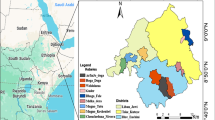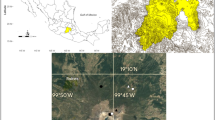Abstract
Few studies have analyzed the production of plant species at regional scales in grassland ecosystems, due in part to limited availability of data at large spatial scales. We used a dataset of rangeland surveys to examine the productivities of 22 plant species throughout the Great Plains of the United States with respect to three environmental factors: temperature, precipitation and soil texture. Productivity of plant species was obtained from Natural Resource Conservation Service (NRCS) range site descriptions. We interpolated climate data from 296 weather stations throughout the region and used soil texture data from NRCS State Soil Geographic (STATSGO) databases. We performed regression analyses to derive models of the relative and absolute production of each species in terms of mean annual temperature (MAT), mean annual precipitation (MAP), and percentage SAND, SILT and CLAY.
MAT was the most important factor for 55% of species analyzed; MAP was most explanatory for 40% of the species, and a soil texture variable was most important for only one species. Production of C3 species tended to be negatively related to MAT, MAP and positively related to CLAY. Production of C4 shortgrasses, in general, was positively related to MAT and negatively related to MAP and SAND, whereas C4 tallgrass productivity tended to be positively associated with MAP and SAND, and was highest at intermediate values of MAT. Our results indicate the extent to which functional types can be used to represent individual species. The regression equations derived in this analysis can be important inclusions in models that assess the effects of climate change on plant communities throughout the region.
Similar content being viewed by others
References
Barnes, P. W. & Harrison, A. T. 1982. Species distribution and community organization in a Nebraska Sandhills mixed prairie as influenced by plant/soil-water relationships. Oecologia 52: 192-201.
Björkman, O., Mooney, H. A. & Ehleringer, J. R. 1975. Photosynthetic responses of plants from habitats with contrasting thermal environments. Carnegie Institute of Washington Yearbook 74: 743-748.
Black, C. C., Jr. 1973. Photosynthetic carbon fixation in relation to net CO2 uptake. Ann. Rev. Plant Physiol. 24: 253-286.
Boutton, T.W., Harrison, A. T. & Smith, B. N. 1980. Distribution of biomass of species differing in photosynthetic pathway along an altitudinal transect in southeastern Wyoming grassland. Oecologia 45: 287-298.
Briggs, J.M. & Knapp, A. K. 1995. Interannual variability in primary production in tallgrass prairie: Climate, soil moisture, topographic position, and fire as determinants of aboveground biomass. Am. J. Bot. 82: 1024-1030.
Brown, D. A. 1993. Early nineteenth-century grasslands of the midcontinent plains. Ann. Assoc. Am. Geographers 83: 589-612.
Brown, D. A. 1989. Physiological and morphological problems for dispersal and survival of grasses in a changing environment. Pp. 25-38. In: Malanson, G. P. (ed), Natural areas facing climate change. Academic Publishing, The Hague, The Netherlands.
Brown, D. A. & Gersmehl, P. J. 1985. Migration models for grasses in American midcontinent. Ann. Assoc. Am. Geographers 75: 383-394.
Burke, I. C., Kittel, T. G. F., Lauenroth, W. K., Snook, P., Yonker, C. M. & Parton, W. J. 1991. Regional analysis of the central Great Plains: Sensitivity to climate variability. Bioscience 41: 685-692.
Caldwell, M. M., Osmond, C. B. & Nott, D. 1977. C4 pathway photosynthesis at low temperature in cold-tolerant Atriplexspecies. Plant Physiol. 60: 157-64.
Cavagnaro, R. 1988. Distribution of C3 and C4 grasses at different altitudes in a temperate arid region of Argentina. Oecologia 76: 273-277.
Chapin, F. S. 1993. Functional role of growth forms in ecosystem and global processes. Pp. 287-312. In: Ehleringer, J. R. & Field, C. B. (eds), Scaling physiological processes. Academic Press, San Diego, CA.
Collins, S. L. & Glenn, S. M. 1990. Hierarchical analysis of species abundance patterns in grassland vegetation. Am. Nat. 135: 633-648.
Coupland, R. T. 1992. Mixed prairie. Pp. 151-179. In: Coupland, R. T. (ed.), Ecosystems of the world 8A: Natural grasslands. Elsevier Science Publishing Co. Inc., New York, NY.
Davidson, E. A. 1995. Spatial covariation of soil organic carbon, clay content, and drainage class at a regional scale. Landscape Ecol. 10: 349-362.
Ehleringer, J. R. & Björkman, O. 1977. Quantum yields for CO2 uptake in C3 and C4 plants: dependence on temperature, CO2 and O2 concentrations. Plant Physiology 59: 86-90.
Ehleringer, J. R. 1978. Implications of quantum yield differences on the distributions of C3 and C4 grasses. Oecologia 31: 255-267.
Ellis, R. P., Vogel, J. C. & Fuls, A. 1980. Photosynthetic pathways and the geographical distribution of grasses in South West Africa/Nambia. South African J. Sci. 76: 307-314.
Epstein, H. E., Lauenroth, W. K., Burke, I. C. & Coffin, D. P. 1996. Productivity patterns of C3 and C4 functional types in the U.S. Great Plains. Ecology 78: 722–731.
Epstein, H. E., Lauenroth, W. K., Burke, I. C. & Coffin, D. P. 1997. Ecological responses of dominant grasses along two climatic gradients in the Great Plains of the United States. J. Veg. Sci. 7: 777–788.
Esser, G. 1992. Implications of climate change for production and decomposition in grasslands and coniferous forests. Ecol. Appl. 2: 47-54.
Fan, W. 1993. Regional analysis of plant species and environmental variables in eastern Colorado. Phd. Dissertation, Colorado State University, Fort Collins, CO.
Great Plains Flora Association. 1986. Flora of the Great Plains. Barkley, T. M. (ed.), University Press of Kansas.
Hattersley, P. W. 1983. The distribution of C3 and C4 grasses in Australia in relation to climate. Oecologia 57: 113-128.
Huston, M. A. 1997. Hidden treatments in ecological experiments: re-evaluating the ecosystem function of biodiversity. Oecologia 110: 449–460.
Kucera, C. L. 1992. Tallgrass prairie. pp. 227-263. In: Coupland, R. T. (ed.), Ecosystems of the world 8A: Natural grasslands. Elsevier Science Publishing Co. Inc. New York, NY.
Lane, D. L. 1995. Above-ground net primary production across a precipitation gradient in the Central Grassland Region. Colorado State University, Masters Thesis.
Lathrop, R. G. Jr., Aber, J. D. & Bognar, J. A. 1995. Spatial variability of digital soil maps and its impact on regional ecosystem modeling. Ecol. Modeling 82: 1-10.
Lauenroth, W. K. & Burke, I. C. 1995. The Great Plains: Climate variability. pp. 237-249. In: Encyclopedia of environmental biology, Volume 2. Academic Press, Inc.
Lauenroth, W. K. & Coffin, D. P. 1992. Belowground processes and the recovery of semiarid grasslands from disturbance. Pp. 131-150. In: Wali, M. K. (ed.), Ecosystem rehabilitation, Vol. 2: Ecosystem analysis and synthesis. SPB Academic Publishing, The Hague, Netherlands.
Lauenroth, W. K. & Milchunas, D. G. 1992. Short-grass steppe. Pp. 183-221. In: Coupland, R. T. (ed.), Ecosystems of the world 8A: Natural grasslands. Elsevier Science Publishing Co. Inc., New York, NY.
Lauenroth, W. K. & Sala, O. E. 1992. Long-term forage production of North American shortgrass steppe. Ecol. Appl. 2: 397–403.
Liang, Y. M., Hazlett, D. L. & Lauenroth, W. K. 1989. Biomass dynamics and water use efficiencies of five plant communities in the shortgrass steppe. Oecologia 80: 148-153.
Melillo, J.M., Callaghan, T. V., Woodward, F. I., Salati, E. & Sinha, S. K. 1992. Effects on ecosystems. Pp. 287-310. In: Coupland, R. T. (ed.), Ecosystems of the World 8A: Natural grasslands. Elsevier, Amsterdam, The Netherlands.
Muhs, D. R. & Maat, P. B. 1993. The potential response of eolian sands to greenhouse warming and precipitation reduction on the Great Plains of the U.S.A. J. Arid Environ. 25: 351-361.
Noy-Meir, I. 1973. Desert ecosystems: environment and producers. Ann. Rev. Ecol. Syst. 4: 23-51.
Olff, H. 1992. Effects of light and nutrient availability on dry matter and N allocation in six successional grassland species. Oecologia 89: 412-421.
Paruelo, J. M., Epstein, H. E., Lauenroth, W. K. & Burke, I. C. 1997. ANPP estimates from NDVI for the Central Grassland Region of the United States. Ecology 78: 953-958.
Paruelo, J. M. & Lauenroth, W. K. 1996. Relative abundance of plant functional types in grasslands and shrublands of North America. Ecol. Appl. 6: 1212-1224.
Prentice, I. C. 1992. Climate change and long-term vegetation dynamics. pp. 292-339. In: Glenn-Lewin, D. C., Peet, R. K. & Veblen, T. T. (eds), Plant succession: Theory and prediction. Chapman & Hall, London, pp. 292-339.
Sala, O. E., Parton, W. J., Joyce, L. A. & Lauenroth, W. K. 1988. Primary production of the Central Grassland Region of the United States. Ecology 69: 40-45.
Sala, O. E., Golluscio, R. A., Lauenroth, W. K. & Soriano, A. 1989. Resource partitioning between shrubs and grasses in the Patagonian steppe. Oecologia 81: 501-505.
Schimel, D. S. 1993. Population and community processes in the response of terrestrial ecosystems to global change. Pp. 45-54. In: Karieva, P. M., Kingsolver, J. G. & Huey, R. B. (eds), Biotic interactions and global change. Sinauer Associates Inc., Sunderland, MA.
Schimel, D. S. & Parton, W. J. 1986. Microclimatic controls of nitrogen mineralization and nitrification in shortgrass steppe soils. Plant Soil 93: 347-357.
Sims, P. L. 1988. Grasslands. pp. 265-286. In: Barbour, M. G. & Billings, W. D. (eds), North American terrestrial vegetation. Cambridge University Press, Cambridge.
Sims, P. L., Singh, J. S. & Lauenroth, W. K. 1978. The structure and function of ten western North American grasslands: I. Abiotic and vegetational characteristics. J. Ecol. 66: 251-285.
Singh, J. S., Lauenroth, W. K., Milchunas, D. G. 1983. Geography of grassland ecosystems. Pp. 46-80. In: Progress in physical geography, Vol. 7.
Smith, T. M., Shugart, H. H., Woodward, F. I. & Burton, P. J. 1993. Plant functional types. Pp. 272-292. In: Solomon, A. M. & Shugart, H. H. (eds), Vegetation dynamics and global change. Chapman and Hall, New York, NY.
Snaydon, R. W. 1991. The productivity of C3 and C4 plants: A reassessment. Functional Ecol. 5: 321-330.
Stubbendieck, J., Hatch, S. L. & Butterfield, C. H. 1992. North American range plants: Fourth edition. University of Nebraska Press, Lincoln, NE.
Tilman, D. 1988. Plant strategies and the dynamics and structure of plant communities. Princeton University Press, Princeton.
Teeri, J. A. & Stowe, L. G. 1976. Climatic patterns and the distribution of C4 grasses in North America. Oecologia 23: 1-12.
USDA Soil Conservation Service. 1967. National handbook for range and related grazing lands.
USDA Soil Conservation Service. 1991. State Soil Geographic Data Base (STATSGO): Data Users Guide. Misc. Publication No. 1492.
Van Veen, J. A., Ladd, J. N. & Amato, M. 1985. Turnover of carbon and nitrogen through the microbial biomass in a sandy loam and a clay soil incubatedwith 14Cglucose and 15N(NH4)2SO4 under different moisture regimes. Soil Biology and Biochemistry 17: 747-756.
Walker, B. H. & Noy-Meir, I. 1982. Aspects of stability and resilience of savanna ecosystems. Pp. 577-590. In: Huntley, B. J. & Walker, B. H. (eds), Ecology of tropical savanna ecosystems. Springer-Verlag, Berlin.
Walter, H. 1971. Natural savannas: Ecology of tropical and subtropical vegetation. Oliver and Boyd, Edinburgh.
Weaver, J. E. 1954. North American prairie. Johnson Publishing Co., Lincoln, NE.
Wedin, D. A. & Tilman, D. 1990. Species effects on nitrogen cycling: a test with perennial grasses. Oecologia 84: 433-441.
Author information
Authors and Affiliations
Rights and permissions
About this article
Cite this article
Epstein, H.E., Lauenroth, W.K., Burke, I.C. et al. Regional productivities of plant species in the Great Plains of the United States. Plant Ecology 134, 173–195 (1998). https://doi.org/10.1023/A:1009732800810
Issue Date:
DOI: https://doi.org/10.1023/A:1009732800810




